Abstract
The effects of cyproheptadine were studied on cardiac Purkinje and ventricular muscle fibres of the dog and on cells of the sinoatrial (SA) node region of rabbit hearts, by means of electrophysiological techniques. Cyproheptadine (2-8 microM) decreased, in a dose-dependent manner, the plateau amplitude and the action potential duration to 50% repolarization of Purkinje and ventricular muscle cells. Higher concentrations also depressed the action potential amplitude, the overshoot and the maximum rate of rise of the upstroke. These effects were only partially reversed on washing. A four fold increase in Ca concentration of the standard Tyrode solution antagonized the effects of cyproheptadine on the action potential characteristics. The 'slow response' obtained in K-depolarized isoprenaline-treated fibres was blocked by cyproheptadine (4 microM). Cyproheptadine (10 microM) depolarized and suppressed the automaticity of spontaneously beating Purkinje fibres. The frequency of discharge of the SA node cells was slowed or abolished by cyproheptadine (2-4 microM). Atropine (2.6 microM) did not affect the negative chronotropic effect, whereas adrenaline (5 microM) reversed it. It is suggested that cyproheptadine depresses the slow inward current in all types of myocardial fibres studied. Higher concentrations might also affect the fast inward sodium current system.
Full text
PDF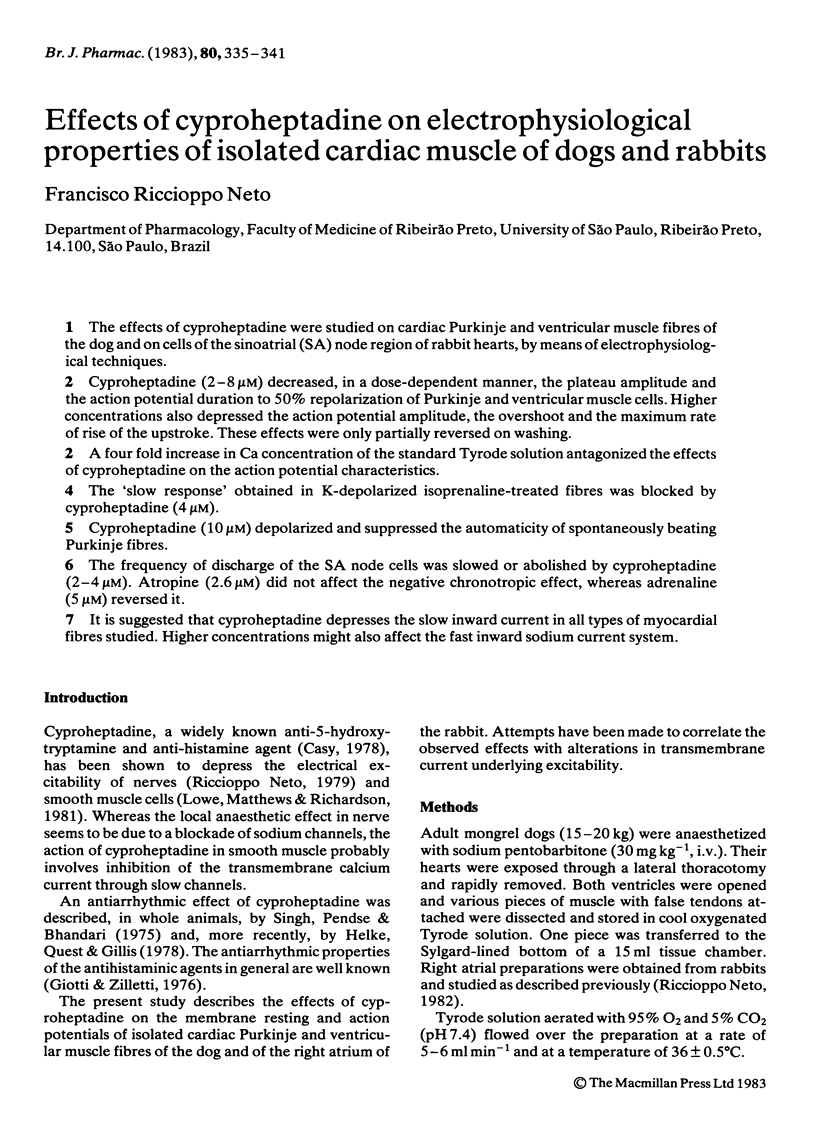
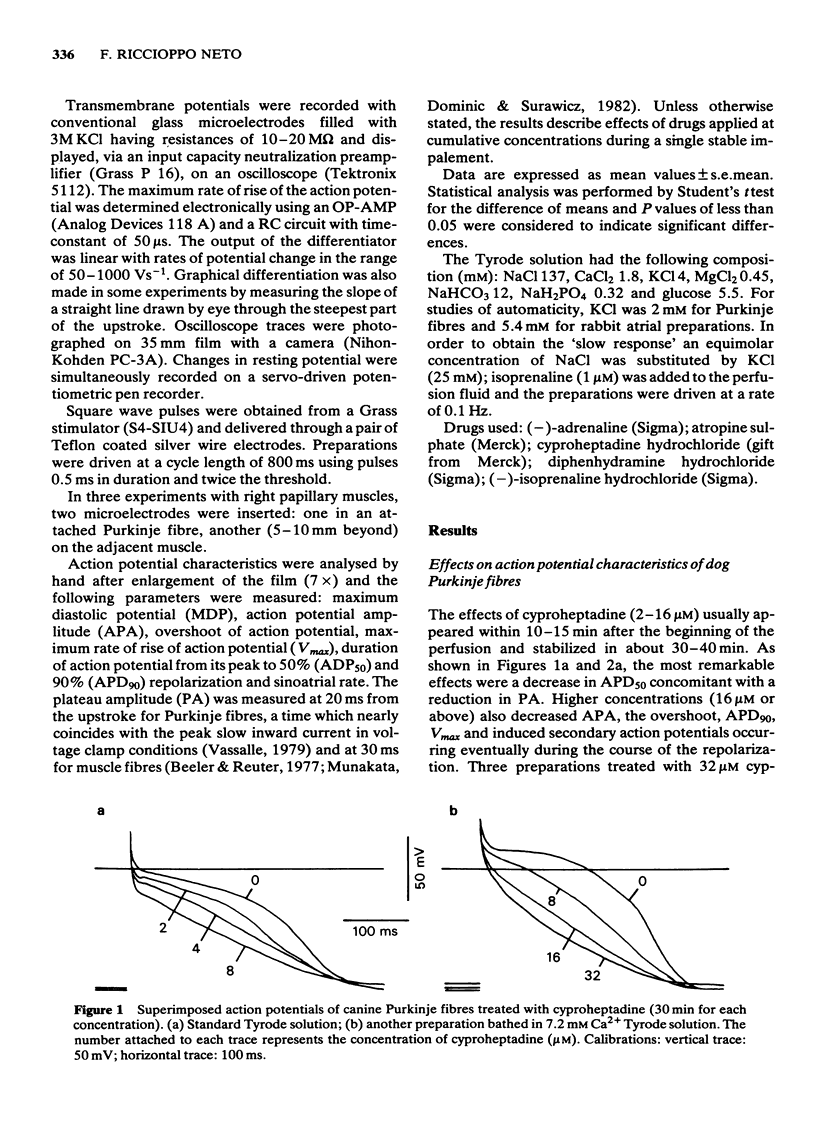
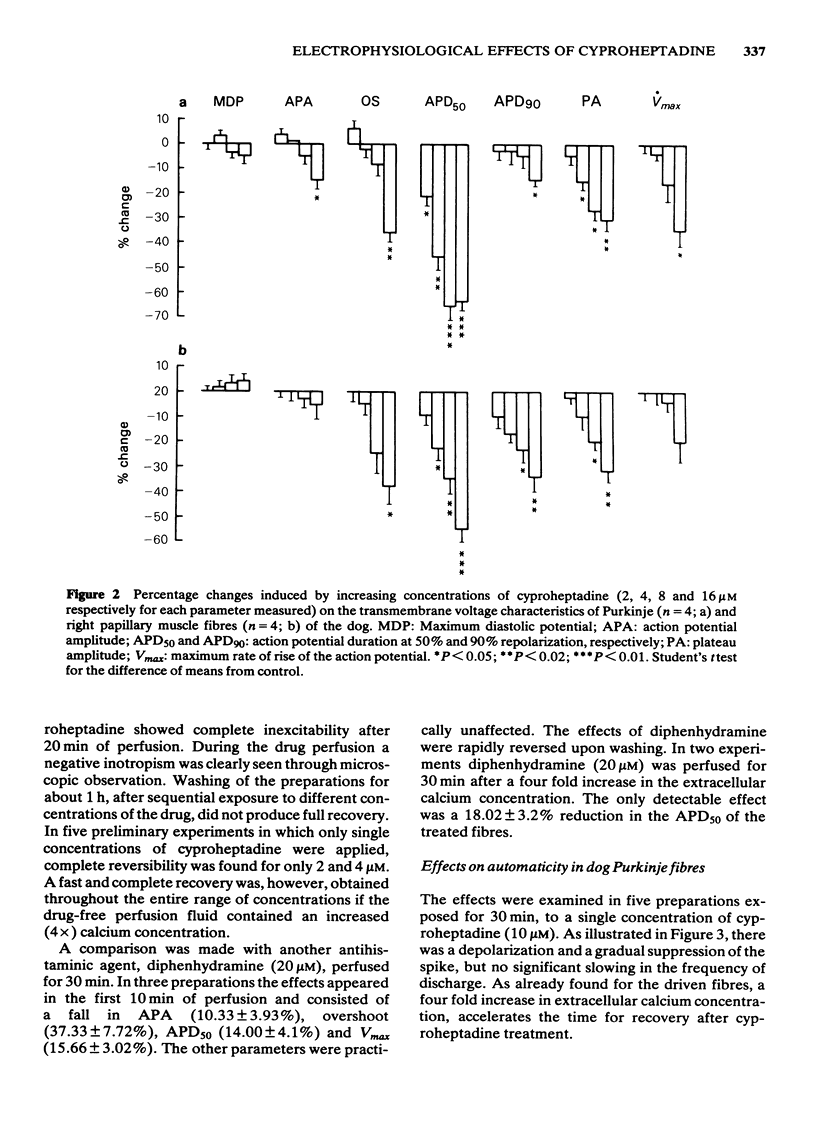
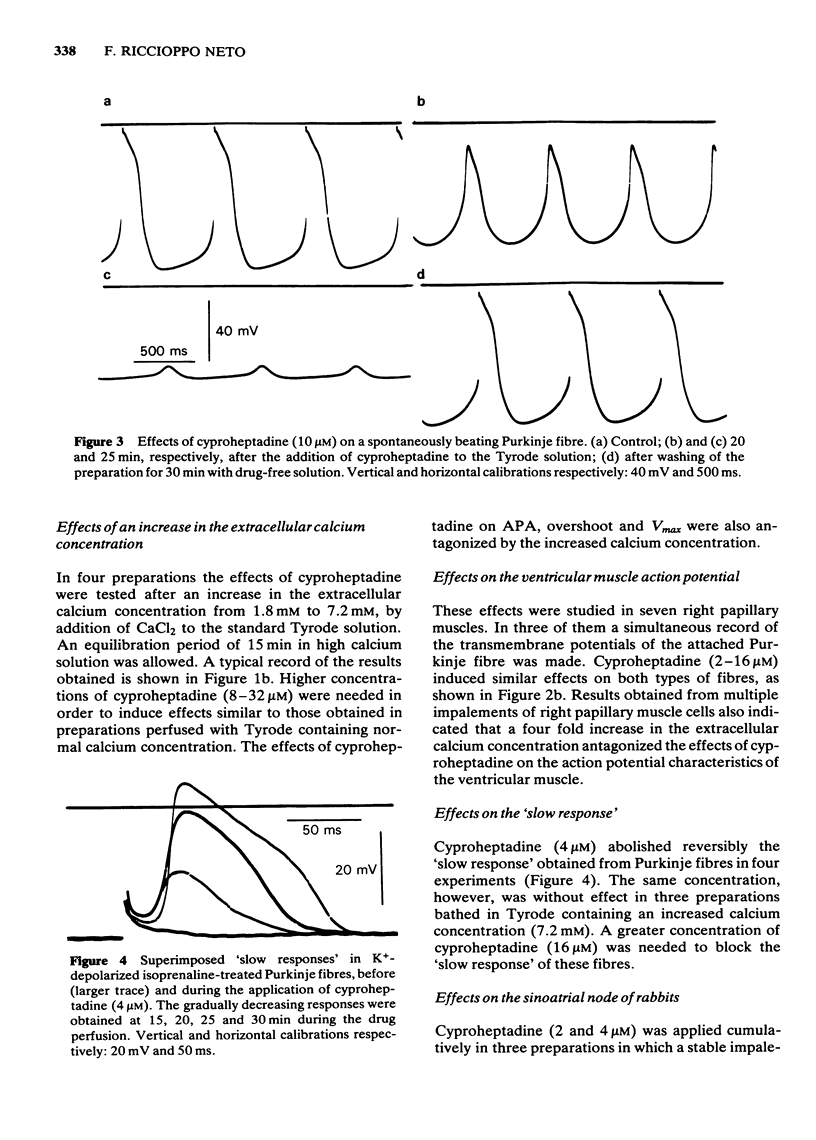
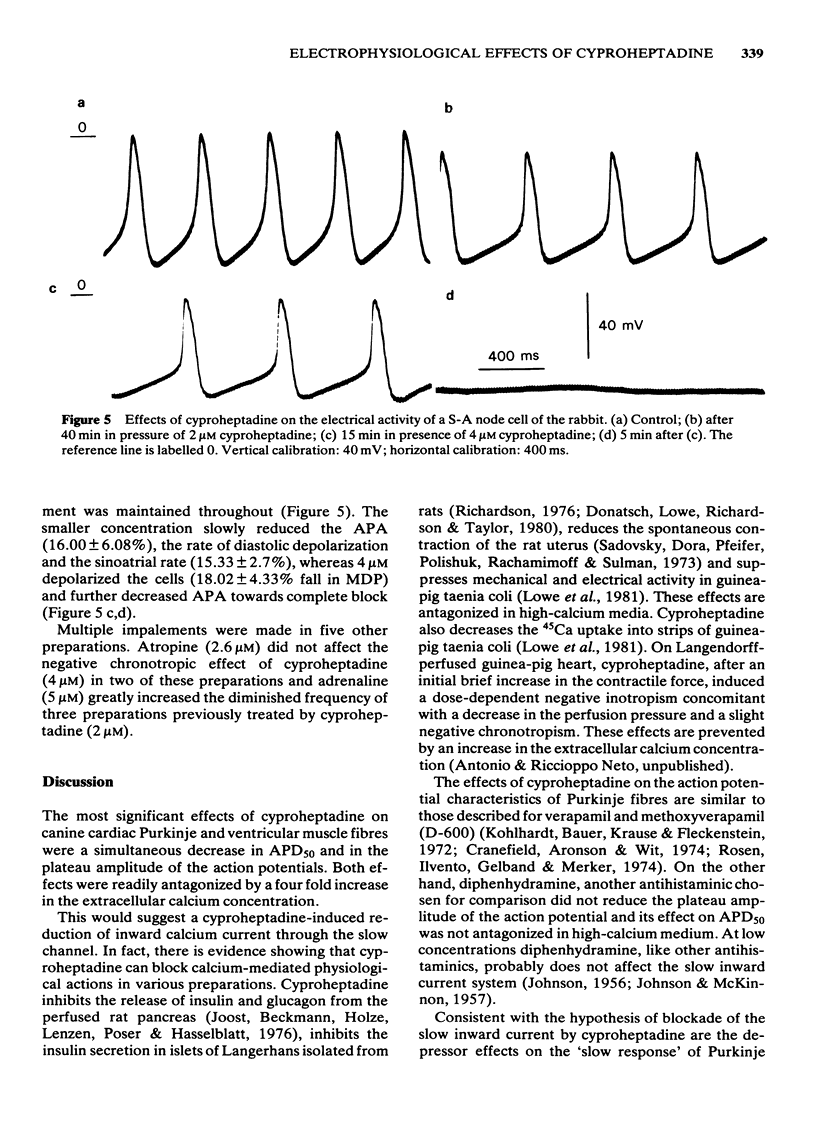
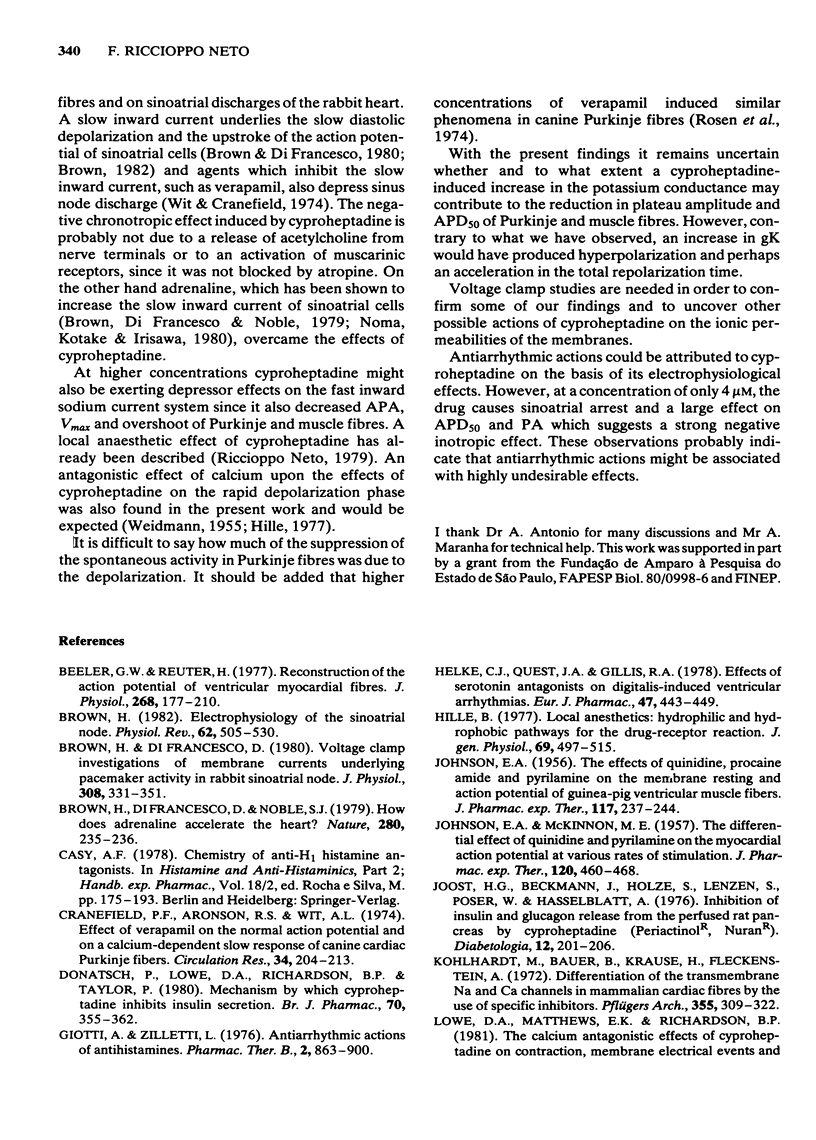
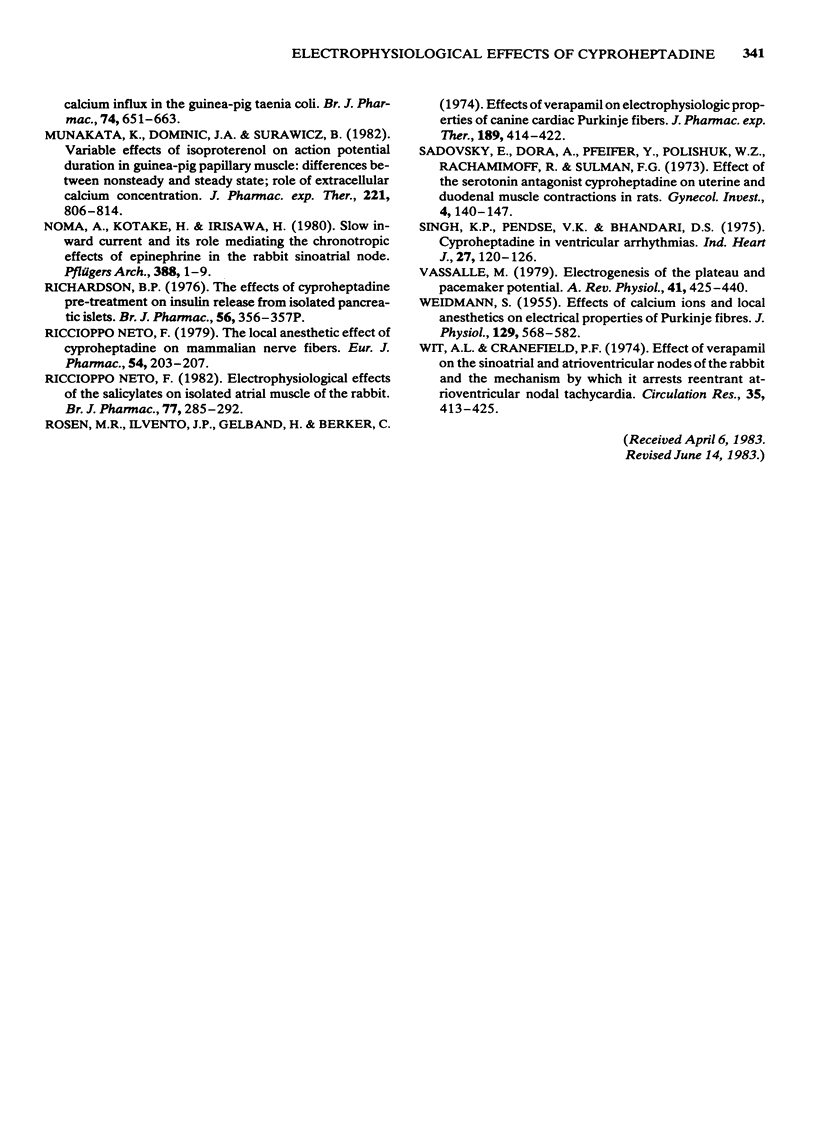
Selected References
These references are in PubMed. This may not be the complete list of references from this article.
- Beeler G. W., Reuter H. Reconstruction of the action potential of ventricular myocardial fibres. J Physiol. 1977 Jun;268(1):177–210. doi: 10.1113/jphysiol.1977.sp011853. [DOI] [PMC free article] [PubMed] [Google Scholar]
- Brown H. F., DiFrancesco D., Noble S. J. How does adrenaline accelerate the heart? Nature. 1979 Jul 19;280(5719):235–236. doi: 10.1038/280235a0. [DOI] [PubMed] [Google Scholar]
- Brown H. F. Electrophysiology of the sinoatrial node. Physiol Rev. 1982 Apr;62(2):505–530. doi: 10.1152/physrev.1982.62.2.505. [DOI] [PubMed] [Google Scholar]
- Brown H., Difrancesco D. Voltage-clamp investigations of membrane currents underlying pace-maker activity in rabbit sino-atrial node. J Physiol. 1980 Nov;308:331–351. doi: 10.1113/jphysiol.1980.sp013474. [DOI] [PMC free article] [PubMed] [Google Scholar]
- Cranefield P. F., Aronson R. S., Wit A. L. Effect of verapamil on the noraml action potential and on a calcium-dependent slow response of canine cardiac Purkinje fibers. Circ Res. 1974 Feb;34(2):204–213. doi: 10.1161/01.res.34.2.204. [DOI] [PubMed] [Google Scholar]
- Donatsch P., Lowe D. A., Richardson B. P., Taylor P. Mechanism by which cyproheptadine inhibits insulin secretion. Br J Pharmacol. 1980 Nov;70(3):355–362. doi: 10.1111/j.1476-5381.1980.tb08710.x. [DOI] [PMC free article] [PubMed] [Google Scholar]
- Giotti A., Zilletti L. Antiarrhythmic actions of antihistamines. Pharmacol Ther B. 1976;2(4):863–900. doi: 10.1016/0306-039x(76)90082-9. [DOI] [PubMed] [Google Scholar]
- Helke C. J., Quest J. A., Gillis R. A. Effects of serotonin antagonists on digitalis-induced ventricular arrhythmias. Eur J Pharmacol. 1978 Feb 15;47(4):443–449. doi: 10.1016/0014-2999(78)90125-5. [DOI] [PubMed] [Google Scholar]
- Hille B. Local anesthetics: hydrophilic and hydrophobic pathways for the drug-receptor reaction. J Gen Physiol. 1977 Apr;69(4):497–515. doi: 10.1085/jgp.69.4.497. [DOI] [PMC free article] [PubMed] [Google Scholar]
- JOHNSON E. A., McKINNON M. G. The differential effect of quinidine and pyrilamine on the myocardial action potential at various rates of stimulation. J Pharmacol Exp Ther. 1957 Aug;120(4):460–468. [PubMed] [Google Scholar]
- JOHNSON E. A. The effects of quinidine, procaine amide and pyrilamine on the membrane resting and action potential of guinea pig ventricular muscle fibers. J Pharmacol Exp Ther. 1956 Jun;117(2):237–244. [PubMed] [Google Scholar]
- Joost H. G., Beckmann J., Holze S., Lenzen S., Poser W., Hasselblatt A. Inhibition of insulin and glucagon release from the perfused rat pancreas by cyproheptadine (Periactinol, Nuran). Diabetologia. 1976 Jul;12(3):201–206. doi: 10.1007/BF00422086. [DOI] [PubMed] [Google Scholar]
- Lowe D. A., Matthews E. K., Richardson B. P. The calcium antagonistic effects of cyproheptadine on contraction, membrane electrical events and calcium influx in the guinea-pig taenia coli. Br J Pharmacol. 1981 Nov;74(3):651–663. doi: 10.1111/j.1476-5381.1981.tb10476.x. [DOI] [PMC free article] [PubMed] [Google Scholar]
- Munakata K., Dominic J. A., Surawicz B. Variable effects of isoproterenol on action potential duration in guinea-pig papillary muscle: differences between nonsteady and steady state; role of extracellular calcium concentration. J Pharmacol Exp Ther. 1982 Jun;221(3):806–814. [PubMed] [Google Scholar]
- Noma A., Kotake H., Irisawa H. Slow inward current and its role mediating the chronotropic effect of epinephrine in the rabbit sinoatrial node. Pflugers Arch. 1980 Oct;388(1):1–9. doi: 10.1007/BF00582621. [DOI] [PubMed] [Google Scholar]
- Riccioppo Neto F. Electrophysiological effects of the salicylates on isolated atrial muscle of the rabbit. Br J Pharmacol. 1982 Oct;77(2):285–292. doi: 10.1111/j.1476-5381.1982.tb09297.x. [DOI] [PMC free article] [PubMed] [Google Scholar]
- Riccioppo Neto F. The local anesthetic effect of cyproheptadine on mammalian nerve fibres. Eur J Pharmacol. 1979 Mar 1;54(3):203–207. doi: 10.1016/0014-2999(79)90078-5. [DOI] [PubMed] [Google Scholar]
- Richardson B. P., Berde B. Proceedings: The effects of cyproheptadine pretreatment on insulin release from isolated pancreatic islets. Br J Pharmacol. 1976 Mar;56(3):356P–357P. [PMC free article] [PubMed] [Google Scholar]
- Rosen M. R., Ilvento J. P., Gelband H., Merker C. Effects of verapamil on electrophysiologic properties of canine cardiac Purkinje fibers. J Pharmacol Exp Ther. 1974 May;189(2):414–422. [PubMed] [Google Scholar]
- Sadovsky E., Dora A., Pfeifer Y., Polishuk W. Z., Rachamimoff R., Sulman F. G. Effect of the serotonin antagonist cyproheptadine on uterine and duodenal muscle contractions in rats. Gynecol Invest. 1973;4(3):140–147. doi: 10.1159/000301717. [DOI] [PubMed] [Google Scholar]
- Singh K. P., Pendse V. K., Bhandari D. S. Cyproheptadine in ventricular arrhythmias. Indian Heart J. 1975 Apr;27(2):120–126. [PubMed] [Google Scholar]
- Vassalle M. Electrogenesis of the plateau and pacemaker potential. Annu Rev Physiol. 1979;41:425–440. doi: 10.1146/annurev.ph.41.030179.002233. [DOI] [PubMed] [Google Scholar]
- WEIDMANN S. Effects of calcium ions and local anesthetics on electrical properties of Purkinje fibres. J Physiol. 1955 Sep 28;129(3):568–582. doi: 10.1113/jphysiol.1955.sp005379. [DOI] [PMC free article] [PubMed] [Google Scholar]
- Wit A. L., Cranefield P. F. Effect of verapamil on the sinoatrial and atrioventricular nodes of the rabbit and the mechanism by which it arrests reentrant atrioventricular nodal tachycardia. Circ Res. 1974 Sep;35(3):413–425. doi: 10.1161/01.res.35.3.413. [DOI] [PubMed] [Google Scholar]


